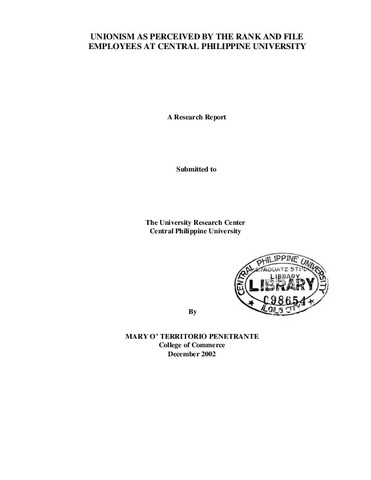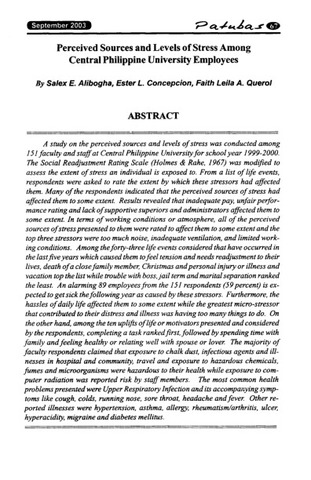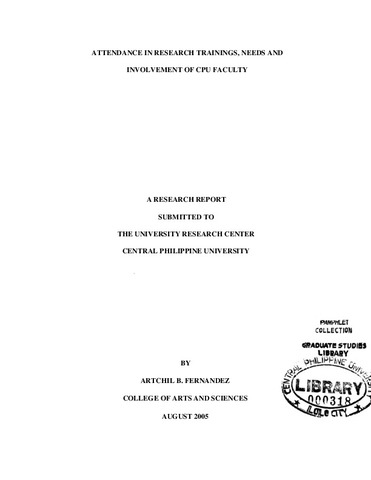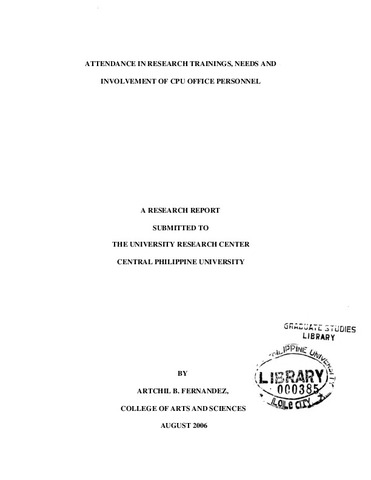Unionism as perceived by the rank and file employees at Central Philippine University
Résumé
The study was conducted to determine the perception on unionism of rank and file employees at Central Philippine University in school year 2002 to 2003 when they are group as to personal, employment and union related profile.
A descriptive research design was used and a one-shot survey method was utilized to gather data. A researcher-made questionnaire, which was duly validated and pre¬ tested, was distributed to 108 randomly selected rank and file employees from the target population of one hundred fifty four (154) rank and file employees in school year 2002- 2003 at Central Philippine University. The data gathered were encoded using the Statistical Package for Social Science software.
Frequency distribution tables were generated together with the means to describe the personal, employment and union related factors of the respondents. To described differences in their perception when group according to the independent variables, cross tabulation tables were generated. To test the null hypothesis, a chi square test was used set at 5 percent level of significance.
The mean age of rank and file employees was 41.78 years old mostly females, married, college graduates, evangelical by religion, regular employees, doing office work and most likely to be union members. Their monthly average income was P9, 487.31 and average length of service in the institution was 14.1 years while their average length of union
Most union members joined the union by their own choice. Their three primary reasons for joining the union were security needs satisfaction, believed in the group’s goal and because of economic reason. Most of them participate in union activities like union meetings, trainings and seminar, few were involved in CBA and strategic planning and decision-making. Generally, their participation in union activities was perceived to be very low with a mean score of 1.7671 in a scale of 1-5 from very low to very high participation.
On the other hand, the three primary reasons of the majority of the non-union members for not joining the labor union were: they do not want to get involve in union activities, do not believed in the cause of the rank and file labor union and because more membership dues to pay, which add up to more deductions in their pay.
The perceived union leadership/decision style by union members was consultative, that is the leader asks inputs from the members but he makes the decision.
Almost all union members perceived that union leadership is performing what they expect from them and among the most perceived advantages in joining the union were: there is strength in workers’ union, security of tenure and protection from labor abuse while the perceived disadvantages were: union members are probable object of management discrimination, deprivation of job promotion, more responsibility and obligations and more fees to pay.
Union members perceived that they are better off as workers when they are unionized. Moreover, they said that they are currently satisfied with their work situation.
For non-union members, their primary reasons for not joining the union were: they do not want to get involve in union or attend union rallies and that there are more union dues to pay and they do not believe in group’s goal. Like union members, they are currently satisfied with their work situation but unlike union members, they perceived that it is better for an employee not to join the union.
Both union and non-union members perceived that the management will provide the same employee benefits even if they are not unionized and among the top five most perceived benefits to be provided to them were salary increases, Christmas bonus, uniform allowance, sick leave benefit and vacation pay, while the least perceived benefits to be provided were: representation of staff in the BOD, overtime pay, extra assignment pay, and retirement extra pay.
No significant difference was found in the rank and file union members’ perception on the advantages of unionism when grouped according to their personal, work and union related factors. However, significant difference exists in their perception on the disadvantages of unionism between males and females, college graduate and elementary graduate, higher income group and low-income group, those groups with longer and shorter length of service in the university and between old and new union members.
Their perception on whether employees are better off when they are unionized significantly differ when grouped according to length of service in the university, length of union membership and who influenced them to join the union.
Based on the findings of the study, it is recommended that union leaders should encourage more active participation from its members, since members’ participation in union activities were rated very low.
The management should encourage continuous education among rank and file employees to further improve positive perception towards labor and management relationship since it was found out that perception on unionism vary as to employees’ highest educational attainment. The management should also provide more socialization avenue to further improve labor-management harmonious relationship and at the same time provide more avenues for employees’ satisfaction of security, and social needs.
Since majority of the rank and file employees are satisfied with their work situation, the management should continuously maintain employee work satisfaction by providing more room for job enrichment to maintain the balance between human basic and higher forms of needs like self-actualization and recognition.
The management and labor should continuously improve their harmonious working relationship and strengthen their commitment toward achieving not only organizational and group goals but eventually for national and social developments.
Union leaders should maintain its consultative leadership/decision styles since majority of their members perceived that the leadership is providing them their expectations and that this type of leadership/decision Style is positively welcome by its members.
Further study is recommended on the effect of the CBA automatic union membership to the employees’ freedom of choice in seeking membership the labor union since differing perception on unionism was found out among older and younger members, higher earning group and low earning group, those who stayed longer and newly regularized employees, and old and new union members. These differing perceptions on unionism could lead to different expectations and satisfaction and as Newstrom and David (1997) said, unless other people realize that others may hold contrasting perception of the same object or event, and unless employees learn to see things as others see them, conflict may arise.
Description
Abstract only
Suggested Citation
Penetrante, M. T. (2002). Unionism as perceived by the rank and file employees at Central Philippine University (Research report). Jaro, Iloilo City: University Research Center, Central Philippine University.
Type
Technical ReportSujet
Shelf Location
GSL 650.072 P375
Physical Description
xi, 68 leaves
Collections
- Research reports [167]
- Research reports [17]
Related items
Showing items related by title, author, creator and subject.
-
Perceived sources and levels of stress among Central Philippine University employees
Alibogha, Salex E.; Concepcion, Ester L.; Querol, Faith Leila A. (Central Philippine University, 2003-09)A study on the perceived sources and levels of stress was conducted among 151 faculty and staff at Central Philippine University for school year 1999-2000. The Social Readjustment Rating Scale (Holmes & Rahe, 1967) was ... -
Attendance in research trainings, needs and involvement of CPU faculty
Fernandez, Artchil B. (Central Philippine University, 2005-08)The study was conducted mainly to determine the attendance in research trainings, needs and research involvement of CPU faculty. It utilized a one-shot survey design. Using Slovin’s formula, a sample of 206 faculty members ... -
Attendance in research trainings, needs and involvement of CPU office personnel
Fernandez, Artchil B. (Central Philippine University, 2006-08)The study was conducted mainly to determine the attendance in research trainings, needs and research involvement of CPU office personnel. It utilized a one-shot survey design. Using census technique (total enumeration), ...





